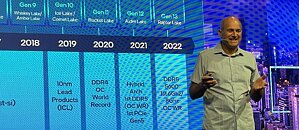- Joined
- Oct 9, 2007
- Messages
- 47,598 (7.45/day)
- Location
- Dublin, Ireland
| System Name | RBMK-1000 |
|---|---|
| Processor | AMD Ryzen 7 5700G |
| Motherboard | Gigabyte B550 AORUS Elite V2 |
| Cooling | DeepCool Gammax L240 V2 |
| Memory | 2x 16GB DDR4-3200 |
| Video Card(s) | Galax RTX 4070 Ti EX |
| Storage | Samsung 990 1TB |
| Display(s) | BenQ 1440p 60 Hz 27-inch |
| Case | Corsair Carbide 100R |
| Audio Device(s) | ASUS SupremeFX S1220A |
| Power Supply | Cooler Master MWE Gold 650W |
| Mouse | ASUS ROG Strix Impact |
| Keyboard | Gamdias Hermes E2 |
| Software | Windows 11 Pro |
With Intel's 13th Gen Core "Raptor Lake" facing stiff competition from AMD's Ryzen 7000 series, and the "Zen 4" series being augmented with 7000X3D series in early-2023, it's becoming a foregone conclusion that Intel will launch a possible "Core i9-13900KS" SKU, which is on its way to being the world's first desktop processor that can boost up to the 6.00 GHz mark. The processor should be able to boost its 8 "Raptor Cove" P-cores to the 6.00 GHz mark, given that the maximum boost frequency of the stock i9-13900K is already rumored to be at 5.70 GHz.
At its Tech Tour event in Israel, Intel confirmed that "Raptor Lake" brings a 15% single-threaded, and 41% multi-threaded performance gain over "Alder Lake." The single-threaded gain is from the higher IPC of the "Raptor Cove" P-core, coupled with its frequency set as high as 5.70 GHz; whereas the multi-threaded performance gain is a combination of increased IPC of the P-cores, and increased frequencies for both the P-cores and E-cores. The E-core clusters get more shared L2 cache, which should improve their performance, too.

View at TechPowerUp Main Site | Source
At its Tech Tour event in Israel, Intel confirmed that "Raptor Lake" brings a 15% single-threaded, and 41% multi-threaded performance gain over "Alder Lake." The single-threaded gain is from the higher IPC of the "Raptor Cove" P-core, coupled with its frequency set as high as 5.70 GHz; whereas the multi-threaded performance gain is a combination of increased IPC of the P-cores, and increased frequencies for both the P-cores and E-cores. The E-core clusters get more shared L2 cache, which should improve their performance, too.

View at TechPowerUp Main Site | Source






